Mervyn Edwards - Illustrated Talks
The titles offered here are aimed at groups and societies interested in history/ local history and are generally fast-moving and lively powerpoint presentations. My starting figure is negotiable, partly depending on geographical area. I require transport from my address in Newcastle-under-Lyme to the venue and transport back.
I cover most of the geographical area of North Staffordshire as well as numerous themes. The following are only a few of my talk titles with some description for the benefit of speaker secretaries.
A TRIP TO THE TUCK SHOP: SWEETS OF YESTERYEAR (NOSTALGIA) (added Mar 2024)
 With a nod to North Staffordshire's old-time sweet shops and Longton’s famous Walker's Nonsuch toffee factory, Mervyn explores the subject of the sweets we grew up with: Bounty, Fry’s Chocolate Cream, Dolly Mixtures, Spangles, Milky Bar, Waggon Wheels and many more. How was this perfection in confection advertised and do you remember some of the slogans and jingles associated with these kiddies’ favourites? We also remember some of the adverts which featured household names of the past such as Petula Clark, Arthur Lowe and John Le Mesurier, Frank Muir and Terry Scott.
With a nod to North Staffordshire's old-time sweet shops and Longton’s famous Walker's Nonsuch toffee factory, Mervyn explores the subject of the sweets we grew up with: Bounty, Fry’s Chocolate Cream, Dolly Mixtures, Spangles, Milky Bar, Waggon Wheels and many more. How was this perfection in confection advertised and do you remember some of the slogans and jingles associated with these kiddies’ favourites? We also remember some of the adverts which featured household names of the past such as Petula Clark, Arthur Lowe and John Le Mesurier, Frank Muir and Terry Scott.
OATCAKES: FOOD OF THE GODS
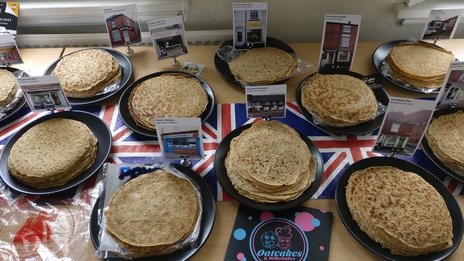 Are you a roller or a folder? Do you know what an “oatcake cake” is? Do you prefer them thick or thin? Which fillings do you prefer in your oatcake – something traditional (cheese and bacon) or exotic (chilli, garlic and herbs)?
Here is a history of the Staffordshire Oatcake offering historical references as well as tales of oatcake eating challenges and the noble art of oatcake throwing.
Hear about celebrities and their fondness for oatcakes - from Arnold Bennett to Pixie Lott – as well as the day when oatcakes,
Wright’s pies and lobby were served up in the Savoy Hotel in London.
A feast of information served up by Mervyn - with or without brown sauce.
Are you a roller or a folder? Do you know what an “oatcake cake” is? Do you prefer them thick or thin? Which fillings do you prefer in your oatcake – something traditional (cheese and bacon) or exotic (chilli, garlic and herbs)?
Here is a history of the Staffordshire Oatcake offering historical references as well as tales of oatcake eating challenges and the noble art of oatcake throwing.
Hear about celebrities and their fondness for oatcakes - from Arnold Bennett to Pixie Lott – as well as the day when oatcakes,
Wright’s pies and lobby were served up in the Savoy Hotel in London.
A feast of information served up by Mervyn - with or without brown sauce.
LET'S DANCE: TRIPPING THE LIGHT FANTASTIC IN THE POTTERIES (added July 2019)
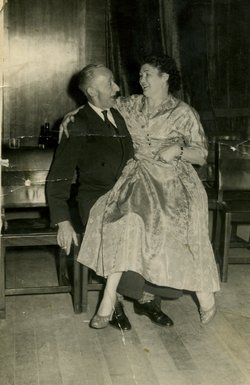 Stokies with stardust in their shoes feature in this talk that recalls how and where and why local people learned to dance, some of the accompanying social rituals and many of the venues where they did it.
Why did Jazz so offend a Penkhull vicar and what social embarrassment happened on the dance floor at Trentham Ballroom during an overly-energetic tango?
Mervyn delights in all manifestations of the Terpsichorean muse as he mentions maypole dancing and the quadrille bands that played on bowling greens and the brass band music so beloved of Potteries people. He also recalls the town halls, the Ideal and the Majestic in Hanley, the Cameo and La Boom Boom in Longton, the Golden Torch in Tunstall and even "Grab a granny night" at the Queen's in Basford.
Stokies with stardust in their shoes feature in this talk that recalls how and where and why local people learned to dance, some of the accompanying social rituals and many of the venues where they did it.
Why did Jazz so offend a Penkhull vicar and what social embarrassment happened on the dance floor at Trentham Ballroom during an overly-energetic tango?
Mervyn delights in all manifestations of the Terpsichorean muse as he mentions maypole dancing and the quadrille bands that played on bowling greens and the brass band music so beloved of Potteries people. He also recalls the town halls, the Ideal and the Majestic in Hanley, the Cameo and La Boom Boom in Longton, the Golden Torch in Tunstall and even "Grab a granny night" at the Queen's in Basford.
FLUSHED WITH SUCCESS: THE STORY OF NORTH STAFFORDSHIRE TOILETS
 Here's an engaging and humorous talk that isn't so much a walk down memory lane so much as a walk out the back. Mervyn examines how we have answered the call of nature over the years, and in doing so he manages to be as discreet and practical as the humble jerry. We discuss Victorian nightsoil men, the importance of Twyford's water closets, duckets and more, using a number of illustrations from the famed sanitary ware gallery at Gladstone Pottery Museum where are housed water closets with impressive-sounding trade names, including The Deluge and the Thunderer! We recall the joys of Izal toilet tissue and also feature a bookshop whose visitor toilet encourages people to read on the loo.
Here's an engaging and humorous talk that isn't so much a walk down memory lane so much as a walk out the back. Mervyn examines how we have answered the call of nature over the years, and in doing so he manages to be as discreet and practical as the humble jerry. We discuss Victorian nightsoil men, the importance of Twyford's water closets, duckets and more, using a number of illustrations from the famed sanitary ware gallery at Gladstone Pottery Museum where are housed water closets with impressive-sounding trade names, including The Deluge and the Thunderer! We recall the joys of Izal toilet tissue and also feature a bookshop whose visitor toilet encourages people to read on the loo.
GRANDMA'S PANTRY (NOSTALGIA)
 This presentation made its debut at the Hempstalls Hall Care Home, near Newcastle and was so much enjoyed by an elderly audience that it has stayed in Mervyn's "set." He recalls the fascination of his own grandmother's pantry beneath the stairs. It was an Aladdin's Cave that had a slight whiff of damp and must, but which nevertheless housed all sorts of colourfully-packaged items. There were Oxo cubes, digestive biscuits, Ovaltine, Camp coffee, Robertson's marmalade, tins of Spam - you all remember the song - Bird's custard, and bottles of Corona and Tizer pop. The vast majority of these goodies were promoted on television in some never-to-be-forgotten advertisements whose catchy songs and jingles are still recalled. Here, we recall the products that gave our childhood a sprinkling of magic, offering history, nostalgia and a jolly good time.
This presentation made its debut at the Hempstalls Hall Care Home, near Newcastle and was so much enjoyed by an elderly audience that it has stayed in Mervyn's "set." He recalls the fascination of his own grandmother's pantry beneath the stairs. It was an Aladdin's Cave that had a slight whiff of damp and must, but which nevertheless housed all sorts of colourfully-packaged items. There were Oxo cubes, digestive biscuits, Ovaltine, Camp coffee, Robertson's marmalade, tins of Spam - you all remember the song - Bird's custard, and bottles of Corona and Tizer pop. The vast majority of these goodies were promoted on television in some never-to-be-forgotten advertisements whose catchy songs and jingles are still recalled. Here, we recall the products that gave our childhood a sprinkling of magic, offering history, nostalgia and a jolly good time.
BIDDULPH GRANGE GARDEN: A POTTED HISTORY
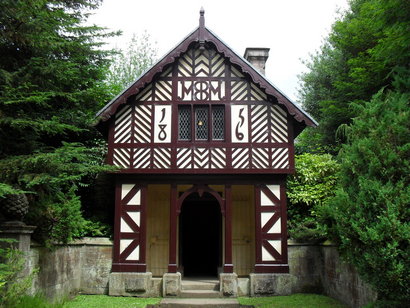 Here's a chance to go to China, Egypt and Italy in one hour, as Mervyn examines the world gardens at Biddulph. Hear about the influences that shaped Bateman's horticultural extravaganza and marvel at the quirky stumpery, upside down tree, Cheshire Cottage and stone frog. This first-class North Staffordshire tourist attraction, owned by the National Trust, offers a surprise around every corner and its enduring delights are conveyed through Mervyn's fascinating slides and thoughtful commentary. An intriguing talk for all those interested in social history and garden development.
Here's a chance to go to China, Egypt and Italy in one hour, as Mervyn examines the world gardens at Biddulph. Hear about the influences that shaped Bateman's horticultural extravaganza and marvel at the quirky stumpery, upside down tree, Cheshire Cottage and stone frog. This first-class North Staffordshire tourist attraction, owned by the National Trust, offers a surprise around every corner and its enduring delights are conveyed through Mervyn's fascinating slides and thoughtful commentary. An intriguing talk for all those interested in social history and garden development.
JOSIAH WEDGWOOD: GIANT OF THE INDUSTRIAL REVOLUTION
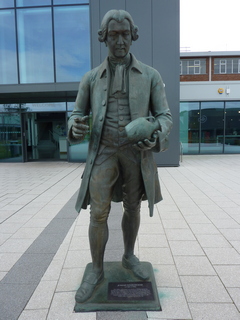 How do we assess Josiah Wedgwood's success as a businessman in the 18th century? It could easily be claimed that he was one of the figures who created what we now call the consumer society. Customers could handle the ware he displayed in his London showrooms. There was a satisfaction-or-your-money-back guarantee, and a delivery service to all parts of England. But like all visionaries, he realised that everything connects to everything else, and his role in the unfolding Industrial Revolution is summed up in his interesting self-assessment:
"As to my private concerns I have almost forgotten them. I scarcely know without a good deal of recollection whether I am a Landed Gentleman, an Engineer, or a Potter, for indeed I am all three & many other characters by turns."
This talk discusses Wedgwood's career as a master potter, innovator and champion of improved communications.
How do we assess Josiah Wedgwood's success as a businessman in the 18th century? It could easily be claimed that he was one of the figures who created what we now call the consumer society. Customers could handle the ware he displayed in his London showrooms. There was a satisfaction-or-your-money-back guarantee, and a delivery service to all parts of England. But like all visionaries, he realised that everything connects to everything else, and his role in the unfolding Industrial Revolution is summed up in his interesting self-assessment:
"As to my private concerns I have almost forgotten them. I scarcely know without a good deal of recollection whether I am a Landed Gentleman, an Engineer, or a Potter, for indeed I am all three & many other characters by turns."
This talk discusses Wedgwood's career as a master potter, innovator and champion of improved communications.
ARNOLD BENNETT'S BURSLEY
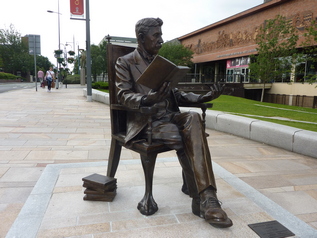 For those who have read Arnold Bennett, and especially for those who haven't, here's an invitation to admire the sense of locality, keen observation and wit of the Potteries' most famous author. Hear why Bennett was so fascinated with Burslem's covered meat market, its potbanks and its pubs - and how life has come to imitate art in the Mother Town, which still boasts of its "Golden Angel," described by Bennett himself. Find out about characters such as Florrie Simcox, the Midlands female clog-dancing champion, and Richard Lovatt, the bank manager who only had to stop a man in the street and murmur, "Oh, by the way - your overdraft," in order to "spread discord and desolation through a refined and pious home." Not forgetting Denry "The Card" Machin, who is "identified with the great cause of cheering us all up." Mervyn suggests some of the sources and inspirations behind Bennett's stories and examines how Bennett saw Burslem and its inhabitants.
For those who have read Arnold Bennett, and especially for those who haven't, here's an invitation to admire the sense of locality, keen observation and wit of the Potteries' most famous author. Hear why Bennett was so fascinated with Burslem's covered meat market, its potbanks and its pubs - and how life has come to imitate art in the Mother Town, which still boasts of its "Golden Angel," described by Bennett himself. Find out about characters such as Florrie Simcox, the Midlands female clog-dancing champion, and Richard Lovatt, the bank manager who only had to stop a man in the street and murmur, "Oh, by the way - your overdraft," in order to "spread discord and desolation through a refined and pious home." Not forgetting Denry "The Card" Machin, who is "identified with the great cause of cheering us all up." Mervyn suggests some of the sources and inspirations behind Bennett's stories and examines how Bennett saw Burslem and its inhabitants.
POTTERS AT THE SEASIDE
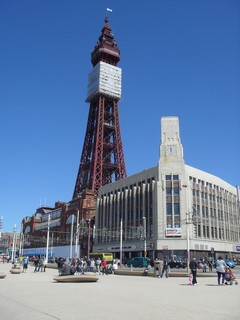 "Oh, we do like to be beside the seaside" was sung with relish by numerous Stokies in times past, and for very good reason. Resorts such as Blackpool were an annual escape for the Potteries people cooped up in the pits and potbanks of industrial Stoke. Rhyl was also popular, with some poorer children visiting the Stoke-on-Trent Children's Convalescent Home long before family funds allowed them to go to the Winkups, Golden Sands and Coventry Co-op holiday camps. Llandudno packed them in and was the setting for scenes in Arnold Bennett's novel The Card. To say nothing of Butlin's and Pontin's camps! Mervyn traces the development of seaside excursions from the early railway trips to full-blown, "kiss me quick" holidays conveniently near to the Potteries.
"Oh, we do like to be beside the seaside" was sung with relish by numerous Stokies in times past, and for very good reason. Resorts such as Blackpool were an annual escape for the Potteries people cooped up in the pits and potbanks of industrial Stoke. Rhyl was also popular, with some poorer children visiting the Stoke-on-Trent Children's Convalescent Home long before family funds allowed them to go to the Winkups, Golden Sands and Coventry Co-op holiday camps. Llandudno packed them in and was the setting for scenes in Arnold Bennett's novel The Card. To say nothing of Butlin's and Pontin's camps! Mervyn traces the development of seaside excursions from the early railway trips to full-blown, "kiss me quick" holidays conveniently near to the Potteries.
A STOKIE'S LIFE IN CARTOONS
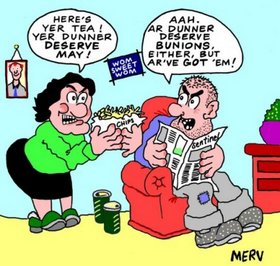 History meets humour in this tongue-in-cheek exposition on Potteries culture. What is culture anyway? To some, it is a visit of Glyndebourne's La Traviata to the Regent Theatre in Hanley, whilst to others, it's a couple of pints of mild ahead of the Vale match. Showcasing many of Mervyn's Sentinel newspaper cartoons, the talk embraces oatcakes, Wright's pies, local dialect, the D Road, supermarkets, potbanks and parochialism - in fact, "all things Stoke," as Mervyn puts it. Along the way, he enlists the help of Arnold Bennett and other commentators who have had much to say about the Potteries and its people. A celebration of local life and lore it ain't - but it's a good chance to look at the foibles and idiosyncrasies of local people through the medium of full-colour cartoons and a bouncy narrative.
History meets humour in this tongue-in-cheek exposition on Potteries culture. What is culture anyway? To some, it is a visit of Glyndebourne's La Traviata to the Regent Theatre in Hanley, whilst to others, it's a couple of pints of mild ahead of the Vale match. Showcasing many of Mervyn's Sentinel newspaper cartoons, the talk embraces oatcakes, Wright's pies, local dialect, the D Road, supermarkets, potbanks and parochialism - in fact, "all things Stoke," as Mervyn puts it. Along the way, he enlists the help of Arnold Bennett and other commentators who have had much to say about the Potteries and its people. A celebration of local life and lore it ain't - but it's a good chance to look at the foibles and idiosyncrasies of local people through the medium of full-colour cartoons and a bouncy narrative.
LOVE AND SEX IN THE POTTERIES
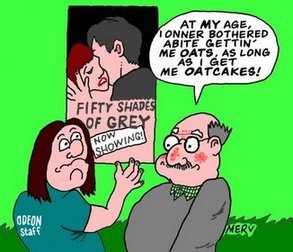 From courtship rituals, to the joys of marriage, broken hearts and the temptations of extra-marital sex, Mervyn lifts the lid on matters of the heart in Stoke and the surrounding area. Here's a talk that, like love itself, promises laughter and tears. For all those who believe that real affection in Stoke is only bestowed on oatcakes, lobby and Wright's pies, Mervyn prepares to woo his audience with stories of why young women ran away from a Longton vicar, the wiles of Burslem's "shilling women" and why it wasn't wise to "play away from home" with Mow Cop women. Mervyn also compares the kissing techniques of Potteries females - though he is quick to point out that his findings are not based on first-hand experience!
From courtship rituals, to the joys of marriage, broken hearts and the temptations of extra-marital sex, Mervyn lifts the lid on matters of the heart in Stoke and the surrounding area. Here's a talk that, like love itself, promises laughter and tears. For all those who believe that real affection in Stoke is only bestowed on oatcakes, lobby and Wright's pies, Mervyn prepares to woo his audience with stories of why young women ran away from a Longton vicar, the wiles of Burslem's "shilling women" and why it wasn't wise to "play away from home" with Mow Cop women. Mervyn also compares the kissing techniques of Potteries females - though he is quick to point out that his findings are not based on first-hand experience!
A CHILD'S LIFE IN THE 19th CENTURY
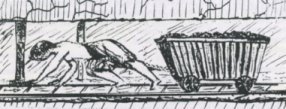 The grinding toil of children's lives on potbanks, in coal mines and in other industries has been brought to life by official reports, autobiography and surviving first-hand accounts. Pity the fourteen year old who worked at the Pinnox Colliery in Burslem. "If I had the same wages in the potbanks I would rather work there running moulds, because I should be out of danger," he attested. "I have seen men as loike to be killed by coal and stone falling upon them." But mould-running was no piece of cake, either, as we know from the memories of Charles Shaw, whose childhood was spent working for local potbanks. He was one of the poor wretches who witnessed the cruel regimes in Chell Workhouse - the "Bastille" - where failed escapees were flogged mercilessly. At this brutal institution, Shaw's meagre diet included workhouse skilly, "an unwholesome decoction of meal and water which might have been boiled in old clothes". Children like him were only permitted to see their mothers on Sunday afternoons. A Child's Life in the 19th Century is an eye-opening account of hard times leavened only by rare joys such as the annual Wakes outing to Trentham.
The grinding toil of children's lives on potbanks, in coal mines and in other industries has been brought to life by official reports, autobiography and surviving first-hand accounts. Pity the fourteen year old who worked at the Pinnox Colliery in Burslem. "If I had the same wages in the potbanks I would rather work there running moulds, because I should be out of danger," he attested. "I have seen men as loike to be killed by coal and stone falling upon them." But mould-running was no piece of cake, either, as we know from the memories of Charles Shaw, whose childhood was spent working for local potbanks. He was one of the poor wretches who witnessed the cruel regimes in Chell Workhouse - the "Bastille" - where failed escapees were flogged mercilessly. At this brutal institution, Shaw's meagre diet included workhouse skilly, "an unwholesome decoction of meal and water which might have been boiled in old clothes". Children like him were only permitted to see their mothers on Sunday afternoons. A Child's Life in the 19th Century is an eye-opening account of hard times leavened only by rare joys such as the annual Wakes outing to Trentham.
A WALK ALONG THE CANALS
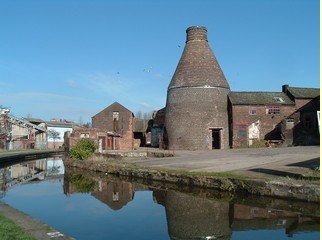 There is a wealth of history to be discovered from the surviving buildings overlooking our canals, but if you're finding it difficult getting down to the towpaths, then re-live the halcyon days of the Canal Age through Mervyn Edwards' slides. Hear about the engineering miracle performed at Harecastle Hill from a speaker who has actually had a go at "legging". He's also actually walked the full length of the Caldon Canal and back (34 miles!) in one day. Revisit some of the industry that overlooked the canals, including the potbanks and the atmospheric "Shelton Bar." What were the pleasures and the perils of the canals for children at play in the 20th century? Which pubs were associated with the canals when working boats were operating? Discover the legacy of James Brindley - the Father of the British Waterways - with Mervyn Edwards.
There is a wealth of history to be discovered from the surviving buildings overlooking our canals, but if you're finding it difficult getting down to the towpaths, then re-live the halcyon days of the Canal Age through Mervyn Edwards' slides. Hear about the engineering miracle performed at Harecastle Hill from a speaker who has actually had a go at "legging". He's also actually walked the full length of the Caldon Canal and back (34 miles!) in one day. Revisit some of the industry that overlooked the canals, including the potbanks and the atmospheric "Shelton Bar." What were the pleasures and the perils of the canals for children at play in the 20th century? Which pubs were associated with the canals when working boats were operating? Discover the legacy of James Brindley - the Father of the British Waterways - with Mervyn Edwards.
HEAPS AND HOLES: THE POTTERIES RECLAIMED
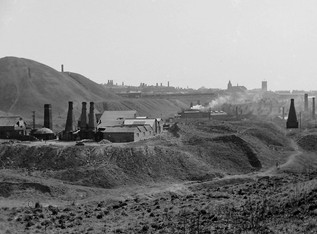 The grimness of the Potteries' industrial landscape was described by commentators as diverse as Arnold Bennett, the architectural historian Nikolaus Pevsner and the politician Richard Crossman. Some flirted with ideas about the romance of industry. Others saw the hole-pocked terrain and called a spade a spade. George Orwell wrote of the Six Towns: "You come upon monstrous clay chasms hundreds of feet across and almost as deep, with little rusty tubs creeping on chain railways up one side, and on the other workmen clinging like samphire-gatherers and cutting into the face of the cliff with their picks. I passed that way in snowy weather, and even the snow was black. The best thing one can say for the pottery towns is that they are fairly small and stop abruptly." Reckless children used spoil tips and marl holes as their adventure playgrounds, not caring that Stoke was blackened in literature as in life. But how was a smoky, pitted "paradise lost" transformed into a green and pleasant land boasting of reclamation schemes such as Central Forest Park in Hanley and Westport Lake in Tunstall? Mervyn Edwards considers how the ugly duckling city became a swan.
The grimness of the Potteries' industrial landscape was described by commentators as diverse as Arnold Bennett, the architectural historian Nikolaus Pevsner and the politician Richard Crossman. Some flirted with ideas about the romance of industry. Others saw the hole-pocked terrain and called a spade a spade. George Orwell wrote of the Six Towns: "You come upon monstrous clay chasms hundreds of feet across and almost as deep, with little rusty tubs creeping on chain railways up one side, and on the other workmen clinging like samphire-gatherers and cutting into the face of the cliff with their picks. I passed that way in snowy weather, and even the snow was black. The best thing one can say for the pottery towns is that they are fairly small and stop abruptly." Reckless children used spoil tips and marl holes as their adventure playgrounds, not caring that Stoke was blackened in literature as in life. But how was a smoky, pitted "paradise lost" transformed into a green and pleasant land boasting of reclamation schemes such as Central Forest Park in Hanley and Westport Lake in Tunstall? Mervyn Edwards considers how the ugly duckling city became a swan.
MERVYN'S CHRISTMAS BOX
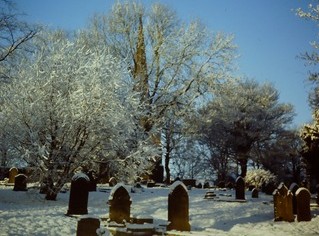 As a man who first played Santa Claus at a department store at the age of 25 - he's had a hard life - Mervyn ought to know something about the magic of the festive season. Hear what it is like to play Father Christmas whilst wearing your Mum's blusher on your cheeks and Tippex on your eyebrows. Come, all ye faithful, to a talk that looks at Christmas shopping, favourite toys, customs and a politically-correct Yuletide. Enter Mervyn's winter wonderland of ice-skating on Rudyard Lake, White Christmases, Geordie Santas and Father Christmas's nicotine break. As Mervyn says, this talk is like a big, fat Christmas pudding: full of interesting ingredients and spice and guaranteed to make you rush to the toilet. Put on your best Christmas jumper and your fake antlers, and join Mervyn for some tidings of comfort and joy.
As a man who first played Santa Claus at a department store at the age of 25 - he's had a hard life - Mervyn ought to know something about the magic of the festive season. Hear what it is like to play Father Christmas whilst wearing your Mum's blusher on your cheeks and Tippex on your eyebrows. Come, all ye faithful, to a talk that looks at Christmas shopping, favourite toys, customs and a politically-correct Yuletide. Enter Mervyn's winter wonderland of ice-skating on Rudyard Lake, White Christmases, Geordie Santas and Father Christmas's nicotine break. As Mervyn says, this talk is like a big, fat Christmas pudding: full of interesting ingredients and spice and guaranteed to make you rush to the toilet. Put on your best Christmas jumper and your fake antlers, and join Mervyn for some tidings of comfort and joy.
ARTHUR BERRY: POEMS OF THE POTTERIES (added Mar 2024)
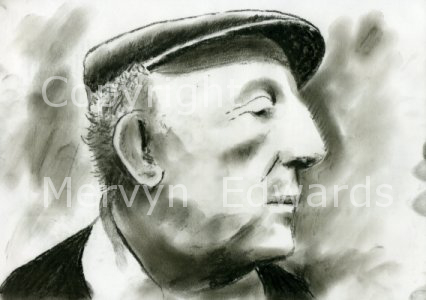 Smallthorne-born Arthur Berry earned fame as a painter, playwright and wordsmith, all of which talents informed his poems which were by turns dark, melancholy and amusing bits of daft. He wrote much engaging poetry in anthologies such as Dandelions and On The Street as well as some idiosyncratic monologues that show a sharp wit, social awareness and love of the absurd. The poems were perhaps a release from the doldrums of middle-aged life but many are hugely entertaining in a laugh-out-loud way. Mervyn explains – and reads – some of these classic evocations of working class life in Stoke.
Smallthorne-born Arthur Berry earned fame as a painter, playwright and wordsmith, all of which talents informed his poems which were by turns dark, melancholy and amusing bits of daft. He wrote much engaging poetry in anthologies such as Dandelions and On The Street as well as some idiosyncratic monologues that show a sharp wit, social awareness and love of the absurd. The poems were perhaps a release from the doldrums of middle-aged life but many are hugely entertaining in a laugh-out-loud way. Mervyn explains – and reads – some of these classic evocations of working class life in Stoke.
CRANKS, CHARACTERS AND QUEER FISH OF NORTH STAFFORDSHIRE
 What is a character? They tend to stand out in society because they cut against the grain - either deliberately or otherwise. They're difficult to label.
The majority of characters Mervyn has known have had a range of traits - generous, amusing, volatile or even aggressive. The vast majority have been politically incorrect because they don't recognise societal norms and many of them have had a dark side, so we tend to call them "rough diamonds" or "loveable rogues," which is sometimes better than they actually deserve. They might be racist, homophobic or misogynistic but they usually get away with it because we say, "That's old Joe. He's a character." Perhaps age allows you the privilege of getting away with remarks much more than you can when you were younger!
Every town or village seemed to have a character, and the Potteries was the stomping ground of such as Tambourine John, the colourful town crier, Klondyke Pete, who once performed a matador act in front of a Hanley tram, Daisy Pattison, the "fat lady" from Newcastle who had once tipped the scales at forty stone and Vincent Riley, the methylated spirits addict and knight of the road whose photograph has regularly appeared in The Sentinel. These and other eccentrics are recalled in Mervyn's presentation.
What is a character? They tend to stand out in society because they cut against the grain - either deliberately or otherwise. They're difficult to label.
The majority of characters Mervyn has known have had a range of traits - generous, amusing, volatile or even aggressive. The vast majority have been politically incorrect because they don't recognise societal norms and many of them have had a dark side, so we tend to call them "rough diamonds" or "loveable rogues," which is sometimes better than they actually deserve. They might be racist, homophobic or misogynistic but they usually get away with it because we say, "That's old Joe. He's a character." Perhaps age allows you the privilege of getting away with remarks much more than you can when you were younger!
Every town or village seemed to have a character, and the Potteries was the stomping ground of such as Tambourine John, the colourful town crier, Klondyke Pete, who once performed a matador act in front of a Hanley tram, Daisy Pattison, the "fat lady" from Newcastle who had once tipped the scales at forty stone and Vincent Riley, the methylated spirits addict and knight of the road whose photograph has regularly appeared in The Sentinel. These and other eccentrics are recalled in Mervyn's presentation.
THE DOCTOR WILL SEE YOU NOW
 Before the arrival of the NHS and the promise of a decent healthcare service "from the cradle to the grave," doctors, dentists, medical practitioners and chemists all played their part in healing sick members of the public - as the old miners and potters of North Staffordshire will remember. Multifarious potions were widely sold for the treatment of everything from running sores to cracked nipples. There was also the well-known baby-pacifier known as Mother's Friend, commonly used in the Potteries - as was the medicinal leech. Here is a talk, suitable for all audiences, that offers interesting information on the work of medical doctors of the 19th century, the treatment of everyday ailments and the perils of going to the dentist.
Before the arrival of the NHS and the promise of a decent healthcare service "from the cradle to the grave," doctors, dentists, medical practitioners and chemists all played their part in healing sick members of the public - as the old miners and potters of North Staffordshire will remember. Multifarious potions were widely sold for the treatment of everything from running sores to cracked nipples. There was also the well-known baby-pacifier known as Mother's Friend, commonly used in the Potteries - as was the medicinal leech. Here is a talk, suitable for all audiences, that offers interesting information on the work of medical doctors of the 19th century, the treatment of everyday ailments and the perils of going to the dentist.
FAGS FOR THE MEMORY: THE RISE AND FALL OF CIGARETTES, WITH PARTICULAR REFERENCE TO NORTH STAFFORDSHIRE
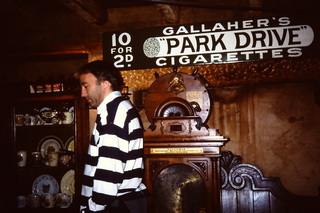 The manufacture of clay tobacco pipes in Newcastle-under-Lyme was only one connection that North Staffordshire has had with the Demon Weed. It was Potteries' author Arnold Bennett - a smoker himself - who wrote that "tobacco is humanizing." Plenty of people were ready to agree with him, with people smoking in Potteries pubs and clubs, theatres and cinemas, on public transport and even in coalmines. But when the health lobby become more and more influential in proving the health risks of smoking, how did the tobacco industry respond? How were more and more women persuaded to take a drag, and how did super-fit footballer Stanley Matthews came to endorse cigarettes? Here's a talk that doesn't preach or pulpiteer, but which does recall the time when smoking was seen as socially-acceptable, sophisticated and even sexy.
The manufacture of clay tobacco pipes in Newcastle-under-Lyme was only one connection that North Staffordshire has had with the Demon Weed. It was Potteries' author Arnold Bennett - a smoker himself - who wrote that "tobacco is humanizing." Plenty of people were ready to agree with him, with people smoking in Potteries pubs and clubs, theatres and cinemas, on public transport and even in coalmines. But when the health lobby become more and more influential in proving the health risks of smoking, how did the tobacco industry respond? How were more and more women persuaded to take a drag, and how did super-fit footballer Stanley Matthews came to endorse cigarettes? Here's a talk that doesn't preach or pulpiteer, but which does recall the time when smoking was seen as socially-acceptable, sophisticated and even sexy.
A NIGHT AT THE FLICKS
(CINEMAS IN NORTH STAFFORDSHIRE)
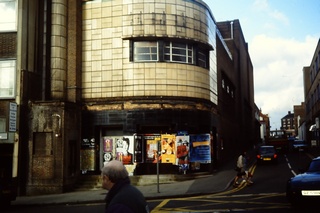 The picture houses of yore enticed people away from the dull, grey streets and off into exotic worlds of glitter and tinsel, impossibly-glamorous women and square-jawed Adonises. Stoke people flocked to grand-sounding venues such as the Coliseum, the Majestic and the Palace - yet our old cinemas were often converted skating rinks or warehouses whose primitive interiors led to them being dubbed the Scratch and the Flea Pit. But it was nothing that a generous spray of Jeyes fluid wouldn't put "right." This talk discusses the shabby wonder of the early picture halls, the gradual improvement of picture house architecture and the rituals of the cinema-going public, mentioning the Tuppenny Rush, naughty boys with pea-shooters and double-seats for courting couples.
The picture houses of yore enticed people away from the dull, grey streets and off into exotic worlds of glitter and tinsel, impossibly-glamorous women and square-jawed Adonises. Stoke people flocked to grand-sounding venues such as the Coliseum, the Majestic and the Palace - yet our old cinemas were often converted skating rinks or warehouses whose primitive interiors led to them being dubbed the Scratch and the Flea Pit. But it was nothing that a generous spray of Jeyes fluid wouldn't put "right." This talk discusses the shabby wonder of the early picture halls, the gradual improvement of picture house architecture and the rituals of the cinema-going public, mentioning the Tuppenny Rush, naughty boys with pea-shooters and double-seats for courting couples.
TALES OF THE UNEXPECTED
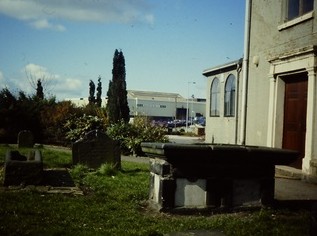 Heigh-ho! A talk about ghosts, myths and legends in North Staffordshire and all that sort of nonsense. But is there another way of looking at the subject? Can ghost sightings be explained or are they truly phenomena that we don't understand? Generations of people have enjoyed the story of Molly Leigh, the alleged Witch of Burslem, without knowing the true facts about her life, which was short. This allegedly gnarled old crone was buried in Burslem churchyard at the tender age of 24. Interest in the supposedly preternatural powers of Molly has endured for so long that perhaps we have overlooked Burslem churchyard's genuine claims to a grisly past - such as the body-snatchers that targeted it in the early 1830s. But what was the unearthly moaning and grumbling sound that in 1835 so troubled Hanley people that some thought it was an omen that the world might end? And for fans of the truly implausible, how do you explain the "flaming, goggle-eyed" Wolstanton Ghost of 1830? Join Mervyn, who says that the truth is out there... somewhere!
Heigh-ho! A talk about ghosts, myths and legends in North Staffordshire and all that sort of nonsense. But is there another way of looking at the subject? Can ghost sightings be explained or are they truly phenomena that we don't understand? Generations of people have enjoyed the story of Molly Leigh, the alleged Witch of Burslem, without knowing the true facts about her life, which was short. This allegedly gnarled old crone was buried in Burslem churchyard at the tender age of 24. Interest in the supposedly preternatural powers of Molly has endured for so long that perhaps we have overlooked Burslem churchyard's genuine claims to a grisly past - such as the body-snatchers that targeted it in the early 1830s. But what was the unearthly moaning and grumbling sound that in 1835 so troubled Hanley people that some thought it was an omen that the world might end? And for fans of the truly implausible, how do you explain the "flaming, goggle-eyed" Wolstanton Ghost of 1830? Join Mervyn, who says that the truth is out there... somewhere!
THE MAGIC OF MUSIC IN THE POTTERIES
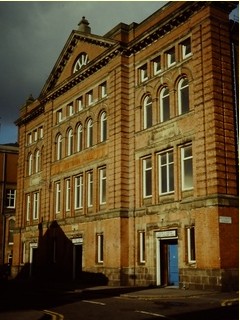 Gertie Gitana - the original Forces' Sweetheart who gave us "Nellie Dean" - was not the only musical talent to come out of North Staffordshire. Among others known for their musical prowess were the master potter Josiah Spode I, cinema pioneer George Barber and the composer Havergal Brian. Working-class interest in music was seen through the wealth of brass bands and choirs in the area, and the singing of colliers in the mining districts. Pubs staged "free and easy" evenings and some even had music halls attached, advertising golden-voiced singers as well as dubious turns that were probably no better than today's bathroom Pavarottis. However, the Victoria Hall in Hanley became a magnet for music-lovers and one of several venues where culture could be enjoyed. Mervyn's talk contains more twists and turns than a treble clef and reminds us of the love of North Staffordshire people for music.
Gertie Gitana - the original Forces' Sweetheart who gave us "Nellie Dean" - was not the only musical talent to come out of North Staffordshire. Among others known for their musical prowess were the master potter Josiah Spode I, cinema pioneer George Barber and the composer Havergal Brian. Working-class interest in music was seen through the wealth of brass bands and choirs in the area, and the singing of colliers in the mining districts. Pubs staged "free and easy" evenings and some even had music halls attached, advertising golden-voiced singers as well as dubious turns that were probably no better than today's bathroom Pavarottis. However, the Victoria Hall in Hanley became a magnet for music-lovers and one of several venues where culture could be enjoyed. Mervyn's talk contains more twists and turns than a treble clef and reminds us of the love of North Staffordshire people for music.
THE NORTH STAFFORDSHIRE COAL MINER
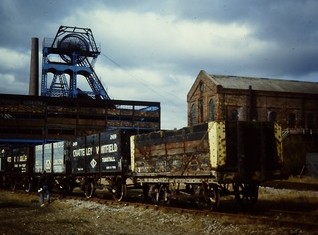 Once an employee of Chatterley Whitfield Mining Museum, Mervyn Edwards was privileged to have descended the working shafts of Hem Heath and Florence Collieries. However, when Silverdale Colliery closed in 1998, coal mining operations in North Staffordshire finally came to an end. Mervyn believes that the miner's story should continue to be told. It's a story of tensions, tragedies and triumphs that embraced hellish conditions underground but great comradeship. George Orwell wrote that it was "only when you see miners down the mine and naked that you realise what splendid men they are." Local author Harold Brown picked up the baton, and in writing his book, Most Splendid of Men described life underground and "up top" in the mining village of Silverdale. Mervyn tells of occupational hazards in the mine, the improvement of working conditions and the miner at leisure, evoking memories of a proud industry that is fast fading into history.
Once an employee of Chatterley Whitfield Mining Museum, Mervyn Edwards was privileged to have descended the working shafts of Hem Heath and Florence Collieries. However, when Silverdale Colliery closed in 1998, coal mining operations in North Staffordshire finally came to an end. Mervyn believes that the miner's story should continue to be told. It's a story of tensions, tragedies and triumphs that embraced hellish conditions underground but great comradeship. George Orwell wrote that it was "only when you see miners down the mine and naked that you realise what splendid men they are." Local author Harold Brown picked up the baton, and in writing his book, Most Splendid of Men described life underground and "up top" in the mining village of Silverdale. Mervyn tells of occupational hazards in the mine, the improvement of working conditions and the miner at leisure, evoking memories of a proud industry that is fast fading into history.
THE POTTERIES PARKS
 Fresh air finally came to the Potteries with the establishment of those lungs for the towns, the municipal parks. In anyone's book, this was an exercise in making a silk purse out of a sow's ear, as the industry-ravaged locations were difficult to convert into green oases. Today, everyone remembers the flowers - but what of the high profile community events that have taken place in them, such as the Potteries Central Horse Parade, the Josiah Wedgwood Bicentenary celebrations and the carnivals? How did park superintendents fare in keeping order in their grounds, in the days when there were lists of park bye-laws as long as your arm? How did local people use these open spaces? Mervyn Edwards also recalls the difficulties of cultivating flora in the smoky Potteries and the achievements of the renowned landscape architect Thomas Mawson. Here's a celebration of our local parks and all that they have meant to us over the years.
Fresh air finally came to the Potteries with the establishment of those lungs for the towns, the municipal parks. In anyone's book, this was an exercise in making a silk purse out of a sow's ear, as the industry-ravaged locations were difficult to convert into green oases. Today, everyone remembers the flowers - but what of the high profile community events that have taken place in them, such as the Potteries Central Horse Parade, the Josiah Wedgwood Bicentenary celebrations and the carnivals? How did park superintendents fare in keeping order in their grounds, in the days when there were lists of park bye-laws as long as your arm? How did local people use these open spaces? Mervyn Edwards also recalls the difficulties of cultivating flora in the smoky Potteries and the achievements of the renowned landscape architect Thomas Mawson. Here's a celebration of our local parks and all that they have meant to us over the years.
THE STAFFORDSHIRE POTTERIES.
 The writer Philip Oakes observed of the old Staffordshire Potteries: "Pot-banks were all around. On foggy days breathing was like trying to inhale over a jug of Friar's Balsam, but in my aunt's house the grime was not allowed to settle." It was a rare woman who could keep her house clean in the days when clay was king in the Six Towns. Indeed, it was rumoured that the working potter even bled "slip" when he cut himself.
The writer Philip Oakes observed of the old Staffordshire Potteries: "Pot-banks were all around. On foggy days breathing was like trying to inhale over a jug of Friar's Balsam, but in my aunt's house the grime was not allowed to settle." It was a rare woman who could keep her house clean in the days when clay was king in the Six Towns. Indeed, it was rumoured that the working potter even bled "slip" when he cut himself.
You may have heard of a skulk of foxes or an ambush of tigers, but what about a bung of saggars? What with bonts, blunging, doughnuts and saggar makers' bottom-knockers, it's tempting to say that you need a degree in linguistics to appreciate the potter's art. And what of the old potbanks and their bottle ovens - those matronly icons of the past, that have attracted the interest of writers including Arnold Bennett, Joseph Priestley and George Orwell? Mervyn Edwards opens a window into the past and immediately has us choking in the billowing smoke.
RAILWAY MANIA
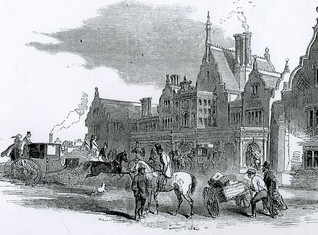 How do you examine a specialist subject and re-package it for general consumption? There are plenty of railway experts around who know their subject inside out, but is it possible to say something of the social history attached to railways in North Staffordshire? Of course it is. Arnold Bennett was no railway buff, but he was an acute observer of local life, and his novels say much about our local railway stations and how they were regarded by Stoke people - as well as the Potteries Loop Line itself. Other folks have memories of the Stockport fish train that called at Tunstall railway station in the 1940s or of Saturday nights at Stoke station during the same period, when well-dressed socialites from Trentham, Barlaston and Endon virtually turned the platform into a catwalk. And what of the old Loop Line, which afforded travellers views of local industry when it as thriving: Shelton Iron and Steel, the pit and brickworks at Sneyd and Hanley Deep Colliery? It's all aboard for an engaging shunt along our local railway lines.
How do you examine a specialist subject and re-package it for general consumption? There are plenty of railway experts around who know their subject inside out, but is it possible to say something of the social history attached to railways in North Staffordshire? Of course it is. Arnold Bennett was no railway buff, but he was an acute observer of local life, and his novels say much about our local railway stations and how they were regarded by Stoke people - as well as the Potteries Loop Line itself. Other folks have memories of the Stockport fish train that called at Tunstall railway station in the 1940s or of Saturday nights at Stoke station during the same period, when well-dressed socialites from Trentham, Barlaston and Endon virtually turned the platform into a catwalk. And what of the old Loop Line, which afforded travellers views of local industry when it as thriving: Shelton Iron and Steel, the pit and brickworks at Sneyd and Hanley Deep Colliery? It's all aboard for an engaging shunt along our local railway lines.
PUBS & BEERHOUSES
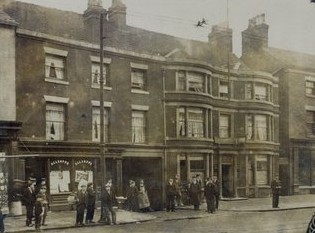 Inns and taverns have long played an important role in society, but the Beer Act of 1830 provided stiff competition as thousands of beerhouses opened up almost overnight, offering the working man yet more opportunities to slake his thirst. Many of these tuppenny-ha'penny beerhouses became fully-licensed pubs themselves, coming to serve the community in multifarious ways: providing entertainment, serving as coaching inns and playing host to meetings of potters, trades unionists and friendly societies. However, the pub was not always a force for the good and was often associated with accepted and unaccepted forms of corruption, notably the paying of workers' wages. Here's a wide-ranging talk that is an overview about how the pub has evolved: its widening appeal to women and the diverse architecture of pub buildings. Among those famous hostelries mentioned are the Leopard in Burslem, the Wheatsheaf in Stoke and the Sneyd Arms in Tunstall. Don't be late. It's opening time!
Inns and taverns have long played an important role in society, but the Beer Act of 1830 provided stiff competition as thousands of beerhouses opened up almost overnight, offering the working man yet more opportunities to slake his thirst. Many of these tuppenny-ha'penny beerhouses became fully-licensed pubs themselves, coming to serve the community in multifarious ways: providing entertainment, serving as coaching inns and playing host to meetings of potters, trades unionists and friendly societies. However, the pub was not always a force for the good and was often associated with accepted and unaccepted forms of corruption, notably the paying of workers' wages. Here's a wide-ranging talk that is an overview about how the pub has evolved: its widening appeal to women and the diverse architecture of pub buildings. Among those famous hostelries mentioned are the Leopard in Burslem, the Wheatsheaf in Stoke and the Sneyd Arms in Tunstall. Don't be late. It's opening time!
POTTERS AT PLAY
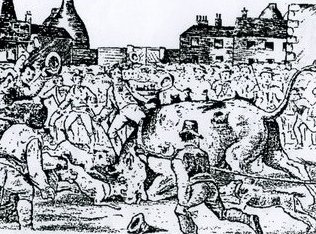 Working class recreation in the Potteries embraced Wakes celebrations and some decidedly primitive forms of amusement - including the baiting of bulls, bears and even rats. Cock-fighting was also popular and was enjoyed many decades after it was banned by Act of Parliament in 1849. Pugilistic bouts were organised in order to settle disputes, or more often because wagers were placed on their outcome. Local men took foot-racing so seriously that they divested themselves of most of their clothes in order to compete - much to the disapprobation of the more respectable. Sportswomen attracted crowds, too - including those robust types who undertook to walk 1,000 miles in 1,000 hours. What with local horse-racing, swimming and other leisure pursuits, there was much to engage potters at play. This story looks at some of the many forms of entertainment that were enjoyed before rational activities such as music and dancing were popularised.
Working class recreation in the Potteries embraced Wakes celebrations and some decidedly primitive forms of amusement - including the baiting of bulls, bears and even rats. Cock-fighting was also popular and was enjoyed many decades after it was banned by Act of Parliament in 1849. Pugilistic bouts were organised in order to settle disputes, or more often because wagers were placed on their outcome. Local men took foot-racing so seriously that they divested themselves of most of their clothes in order to compete - much to the disapprobation of the more respectable. Sportswomen attracted crowds, too - including those robust types who undertook to walk 1,000 miles in 1,000 hours. What with local horse-racing, swimming and other leisure pursuits, there was much to engage potters at play. This story looks at some of the many forms of entertainment that were enjoyed before rational activities such as music and dancing were popularised.
NORTH STAFFORDSHIRE WOMEN
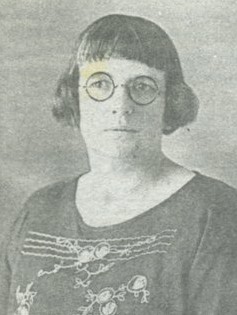 One of Mervyn's most popular talks, this presentation looks at the lives of a clutch of women who made their mark in North Staffordshire. They include pottery designer Clarice Cliff, one of the most fascinating creative talents ever to emerge from the Potteries - and yet her exuberantly-coloured commercial designs were labelled "awful" by Queen Mary. Recall the good deeds of two very different political and social campaigners: Millicent, Duchess of Sutherland (the Princess Diana of her day) as well as the spitfire from Silverdale who gave her name to the Fanny Deakin Maternity Home. Hear of women who muscled their way to the front in male-dominated areas of operation; ladies whose determination to succeed enabled them to overcome prejudices and social constraints. Mervyn invites his audience to consider how the woman's role in society has changed, viewed through his short biographies of his favourite North Staffordshire Women.
One of Mervyn's most popular talks, this presentation looks at the lives of a clutch of women who made their mark in North Staffordshire. They include pottery designer Clarice Cliff, one of the most fascinating creative talents ever to emerge from the Potteries - and yet her exuberantly-coloured commercial designs were labelled "awful" by Queen Mary. Recall the good deeds of two very different political and social campaigners: Millicent, Duchess of Sutherland (the Princess Diana of her day) as well as the spitfire from Silverdale who gave her name to the Fanny Deakin Maternity Home. Hear of women who muscled their way to the front in male-dominated areas of operation; ladies whose determination to succeed enabled them to overcome prejudices and social constraints. Mervyn invites his audience to consider how the woman's role in society has changed, viewed through his short biographies of his favourite North Staffordshire Women.